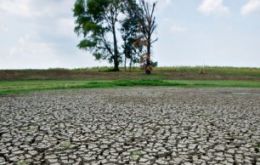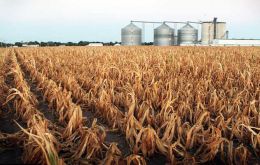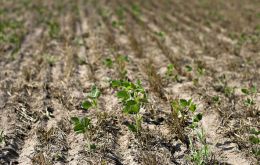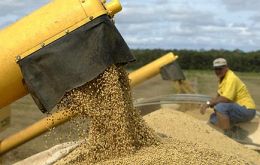MercoPress. South Atlantic News Agency
Tag: drought
-
Friday, September 7th 2012 - 06:25 UTC
FAO says global food prices remained steady in August, but “the game is not over”

Global food prices remained steady in August, the United Nations food agency said Thursday, but warned that “the game is not over” as it was only the beginning of the harvest season.
-
Friday, August 31st 2012 - 04:46 UTC
Global food prices index soars 10% in July: World Bank sound the alarm

Global food prices soared by 10% in July from a month ago, with maize and soybean reaching all-time peaks due to an unprecedented summer of droughts and high temperatures in both the United States and Eastern Europe, according to the World Bank Group’s latest Food Price Watch report.
-
Friday, August 31st 2012 - 04:42 UTC
Soy reaches record price at 650 dollars the ton, and could keep climbing

Soy beans in Chicago climbed to their highest having advanced 0.4% on Thursday to 650.47 dollars the ton, while corn up 0.2% to 319.47 dollars the ton came closer to its record value of last August, 327.25 dollars. Wheat meantime slid 0.2% to 324.64 dollars the ton.
-
Thursday, August 16th 2012 - 20:07 UTC
Wheat futures up in the US and Europe on fears Russia might restrict exports

US and European wheat futures gained again on Thursday as importers took advantage of a price fall earlier in the week and as operators continued to anticipate Russia would drop out of export markets in the coming months due to drought-hit supply.
-
Tuesday, August 14th 2012 - 07:31 UTC
Obama announces 170m dollars emergency support for scorched farms

President Barack Obama announced an emergency purchase of up to 170 million dollars of meat and fish on Monday on a campaign trip to drought-hit Iowa, and accused Republican vice presidential candidate Paul Ryan of blocking disaster aid to farmers.
-
Thursday, July 19th 2012 - 18:17 UTC
US worst drought since 1956 sends soybeans and corn skyrocketing

The commodities soy and corn’s prizes sky rocked on Thursday thanks to the severe drought that has been punishing the United States heartland. Soy and corn were being sold at record high of 638.89 dollars/ton and 320.26 dollars/ton respectively.
-
Monday, July 16th 2012 - 23:55 UTC
Drought stretching across US threatens economies of farming states and food prices

A worst-in-a-generation drought from stretching across the United States is damaging crops and rural economies and threatening to drive food prices to record levels. Agriculture, though a small part (1.2%) of the 15.5 trillion dollars US economy, had been one of the most resilient industries in the past three years as the country struggled to recover from the recession.
-
Saturday, July 14th 2012 - 00:26 UTC
Brazil’s 2012/13 soybean crop in place to dispute the US supremacy

Next season, 2012/13 Brazilian soybean growers could be in place to jump from the world's No. 2 producer and dispute the US first place. Brazil's 2012-13 soybean production is expected to rise 25% from this season’s drought-punished, to 83.1 million tons.
-
Thursday, June 21st 2012 - 05:46 UTC
Drought hit Argentina soy beans and corn crops really hard

Argentina's biggest grains exchange trimmed its forecast for 2011/12 soy output this week to 40.5 million tons, down from May's estimate of 40.9 million tons as harvesting enters the home stretch.
-
Tuesday, March 20th 2012 - 01:19 UTC
Drought punishing soy crops and yields in southern Brazil

Drought over Brazil's southern soy growing states prompted analysts Agroconsult to strike 2.8 million tons from its forecast of the 2011/12 crop to 67.1 million tons from 69.9 million previously.
